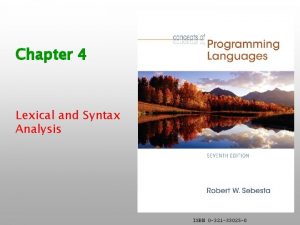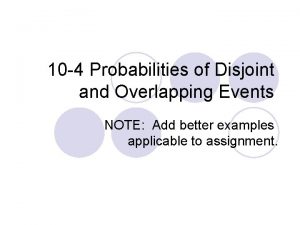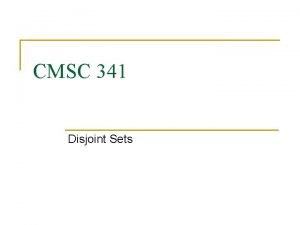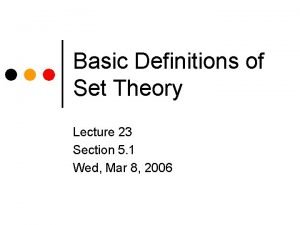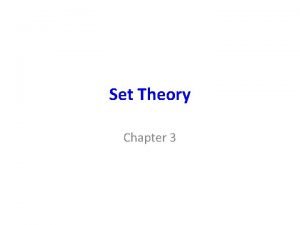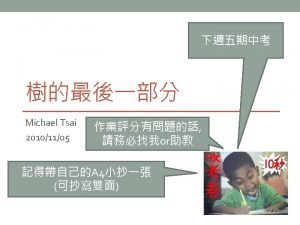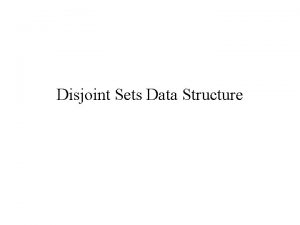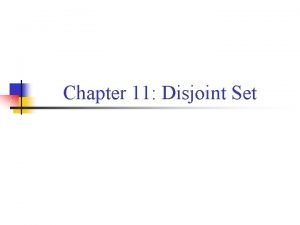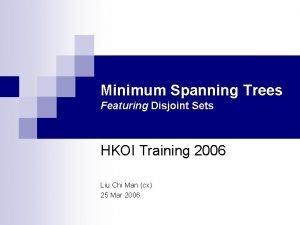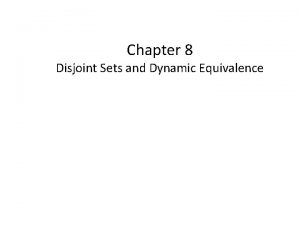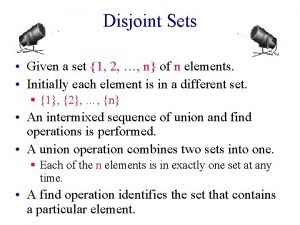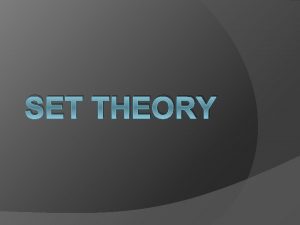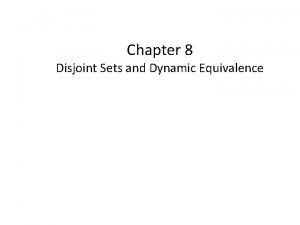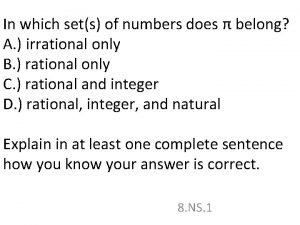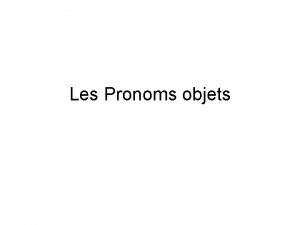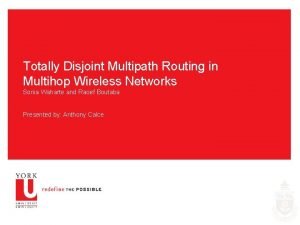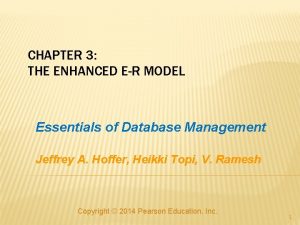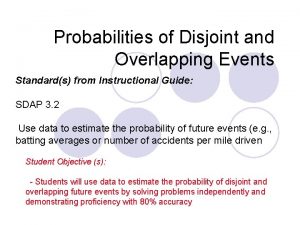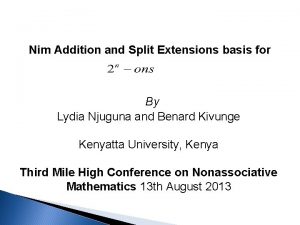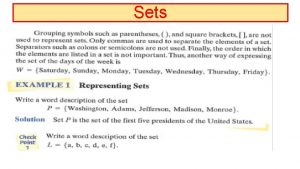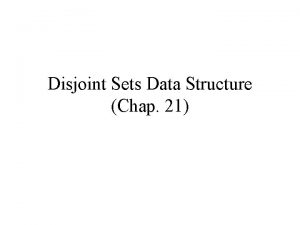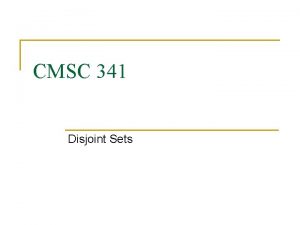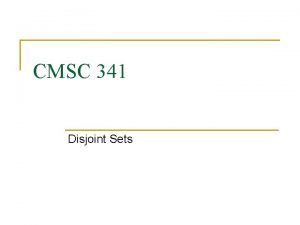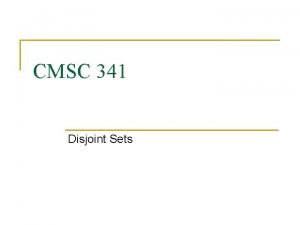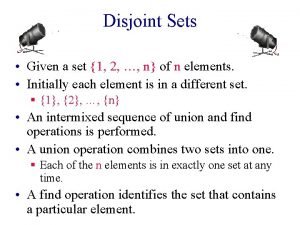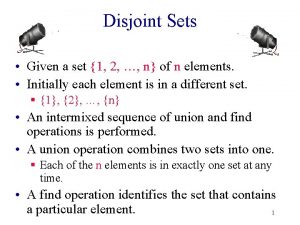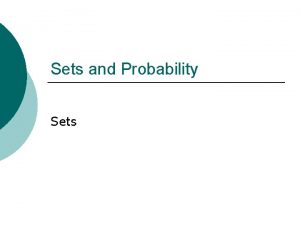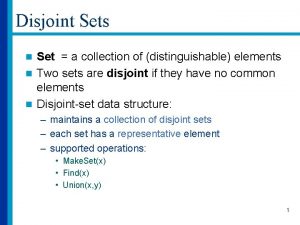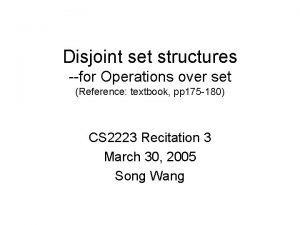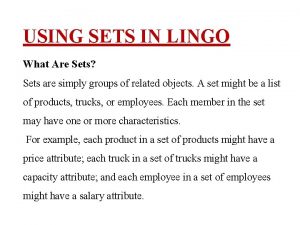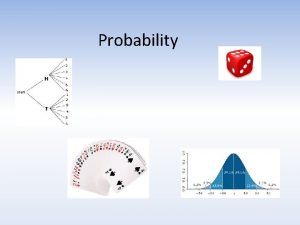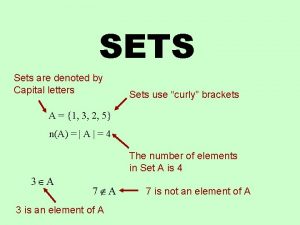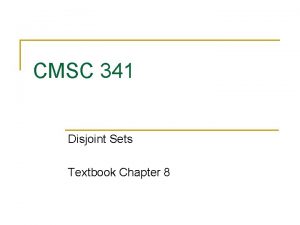Disjoint Sets Given a set 1 2 n







![Example 13 4 5 9 11 30 2 1 table[] 0 5 10 15 Example 13 4 5 9 11 30 2 1 table[] 0 5 10 15](https://slidetodoc.com/presentation_image/8d5b734a2ab1e36d9862e4205c4da5e0/image-8.jpg)
![Better Representation • Use an integer array parent[] such that parent[i] is the element Better Representation • Use an integer array parent[] such that parent[i] is the element](https://slidetodoc.com/presentation_image/8d5b734a2ab1e36d9862e4205c4da5e0/image-9.jpg)


![The Union Method void Simple. Union(int i, int j) {parent[i] = j; } The Union Method void Simple. Union(int i, int j) {parent[i] = j; }](https://slidetodoc.com/presentation_image/8d5b734a2ab1e36d9862e4205c4da5e0/image-12.jpg)

![The Find Method int Simple. Find(int i) { while (parent[i] >= 0) i = The Find Method int Simple. Find(int i) { while (parent[i] >= 0) i =](https://slidetodoc.com/presentation_image/8d5b734a2ab1e36d9862e4205c4da5e0/image-14.jpg)













![Time Complexity Lemma 5. 6 [Tarjan and Van Leeuwen] Let T(f, u) be the Time Complexity Lemma 5. 6 [Tarjan and Van Leeuwen] Let T(f, u) be the](https://slidetodoc.com/presentation_image/8d5b734a2ab1e36d9862e4205c4da5e0/image-28.jpg)
- Slides: 28

Disjoint Sets • Given a set {1, 2, …, n} of n elements. • Initially each element is in a different set. § {1}, {2}, …, {n} • An intermixed sequence of union and find operations is performed. • A union operation combines two sets into one. § Each of the n elements is in exactly one set at any time. • A find operation identifies the set that contains a particular element.

Using Arrays And Chains • Best time complexity using arrays and chains is O(n + u log u + f), where u and f are, respectively, the number of union and find operations that are done. • Using a tree (not a binary tree) to represent a set, the time complexity becomes almost O(n + f) (assuming at least n/2 union operations).

A Set As A Tree • S = {2, 4, 5, 9, 11, 13, 30} • Some possible tree representations: 5 4 13 2 9 11 30 5 9 2 5 11 4 11 13 4 13 2 9 30 30

Result Of A Find Operation • Find(i) is to identify the set that contains element i. • In most applications of the union-find problem, the user does not provide set identifiers. • The requirement is that Find(i) and Find(j) return the same value iff elements i and j are in the same set. 4 2 9 11 30 5 13 Find(i) will return the element that is in the tree root.

Strategy For Find(i) 13 4 9 5 11 30 2 • Start at the node that represents element i and climb up the tree until the root is reached. • Return the element in the root. • To climb the tree, each node must have a parent pointer.

Trees With Parent Pointers 7 13 4 9 5 11 8 3 22 30 10 2 1 6 20 16 14 12

Possible Node Structure • Use nodes that have two fields: element and parent. § Use an array table[] such that table[i] is a pointer to the node whose element is i. § To do a Find(i) operation, start at the node given by table[i] and follow parent fields until a node whose parent field is null is reached. § Return element in this root node.
![Example 13 4 5 9 11 30 2 1 table 0 5 10 15 Example 13 4 5 9 11 30 2 1 table[] 0 5 10 15](https://slidetodoc.com/presentation_image/8d5b734a2ab1e36d9862e4205c4da5e0/image-8.jpg)
Example 13 4 5 9 11 30 2 1 table[] 0 5 10 15 (Only some table entries are shown. )
![Better Representation Use an integer array parent such that parenti is the element Better Representation • Use an integer array parent[] such that parent[i] is the element](https://slidetodoc.com/presentation_image/8d5b734a2ab1e36d9862e4205c4da5e0/image-9.jpg)
Better Representation • Use an integer array parent[] such that parent[i] is the element that is the parent of element i. 13 4 9 5 11 30 2 1 parent[] 2 9 0 13 13 5 4 5 10 0 15

Union Operation • Union(i, j) § i and j are the roots of two different trees, i != j. • To unite the trees, make one tree a subtree of the other. § parent[j] = i

Union Example 7 8 13 4 9 3 22 6 5 10 11 2 1 • Union(7, 13) 30 20 16 14 12
![The Union Method void Simple Unionint i int j parenti j The Union Method void Simple. Union(int i, int j) {parent[i] = j; }](https://slidetodoc.com/presentation_image/8d5b734a2ab1e36d9862e4205c4da5e0/image-12.jpg)
The Union Method void Simple. Union(int i, int j) {parent[i] = j; }

Time Complexity Of Simple. Union() • O(1)
![The Find Method int Simple Findint i while parenti 0 i The Find Method int Simple. Find(int i) { while (parent[i] >= 0) i =](https://slidetodoc.com/presentation_image/8d5b734a2ab1e36d9862e4205c4da5e0/image-14.jpg)
The Find Method int Simple. Find(int i) { while (parent[i] >= 0) i = parent[i]; // move up the tree return i; }

Time Complexity of Simple. Find() • Tree height may equal number of elements in tree. § Union(2, 1), Union(3, 2), Union(4, 3), Union(5, 4)… 5 3 4 2 1 So complexity is O(u).

u Unions and f Find Operations • O(u + uf) = O(uf) • Time to initialize parent[i] = 0 for all i is O(n). • Total time is O(n + uf). • Worse than using a chain! • Back to the drawing board.

Smart Union Strategies 7 13 4 9 5 11 8 3 22 30 2 1 6 10 20 16 14 • Union(7, 13) • Which tree should become a subtree of the other? 12

Height Rule • Make tree with smaller height a subtree of the other tree. • Break ties arbitrarily. 13 4 9 7 5 11 30 8 3 22 6 2 1 10 Union(7, 13) 20 16 14 12

Weight Rule • Make tree with fewer number of elements a subtree of the other tree. 7 • Break ties arbitrarily. 13 4 9 8 3 22 6 5 11 10 30 2 1 Union(7, 13) 20 16 14 12

Implementation • Root of each tree must record either its height or the number of elements in the tree. • When a union is done using the height rule, the height increases only when two trees of equal height are united. • When the weight rule is used, the weight of the new tree is the sum of the weights of the trees that are united.

Height Of A Tree • Suppose we start with single element trees and perform unions using either the height or the weight rule. • The height of a tree with p elements is at most floor (log 2 p) + 1. • Proof is by induction on p. See text.

Sprucing Up The Find Method 7 13 4 9 e 2 1 d f 8 3 22 6 5 g 11 10 30 20 16 a, b, c, d, e, f, and g are subtrees a b c • Find(1) • Do additional work to make future finds easier. 14 12

Path Compaction • Make all nodes on find path point to tree root. • Find(1) 7 13 4 9 e 2 1 d a b c f 8 3 22 6 5 g 11 10 30 20 16 a, b, c, d, e, f, and g are subtrees Makes two passes up the tree. 14 12

Path Splitting • Nodes on find path point to former grandparent. • Find(1) 7 13 4 9 e 2 1 d a b c f 8 3 22 6 5 g 11 10 30 20 16 a, b, c, d, e, f, and g are subtrees Makes only one pass up the tree. 14 12

Path Halving • Parent pointer in every other node on find path is changed to former grandparent. • Find(1) 7 13 4 9 e 2 1 d a b c f 8 3 22 6 5 g 11 10 30 20 16 a, b, c, d, e, f, and g are subtrees Changes half as many pointers. 14 12

Time Complexity • Ackermann’s function. § A(i, j) = 2 j, i = 1 and j >= 1 § A(i, j) = A(i-1, 2), i >= 2 and j = 1 § A(i, j) = A(i-1, A(i, j-1)), i, j >= 2 • Inverse of Ackermann’s function. § a(p, q) = min{z>=1 | A(z, p/q) > log 2 q}, p >= q >= 1

Time Complexity • Ackermann’s function grows very rapidly as i and j are increased. § A(2, 4) = 265, 536 • The inverse function grows very slowly. § a(p, q) < 5 until q = 2 A(4, 1) § A(4, 1) = A(2, 16) >>>> A(2, 4) • In the analysis of the union-find problem, q is the number, n, of elements; p = n + f; and u >= n/2. • For all practical purposes, a(p, q) < 5.
![Time Complexity Lemma 5 6 Tarjan and Van Leeuwen Let Tf u be the Time Complexity Lemma 5. 6 [Tarjan and Van Leeuwen] Let T(f, u) be the](https://slidetodoc.com/presentation_image/8d5b734a2ab1e36d9862e4205c4da5e0/image-28.jpg)
Time Complexity Lemma 5. 6 [Tarjan and Van Leeuwen] Let T(f, u) be the maximum time required to process any intermixed sequence of f finds and u unions. Assume that u >= n/2. k 1*(n + f*a(f+n, n)) <= T(f, u) <= k 2*(n + f*a(f+n, n)) where k 1 and k 2 are constants. These bounds apply when we start with singleton sets and use either the weight or height rule for unions and any one of the path compression methods for a find.
 Pairwise disjoint test
Pairwise disjoint test Mutually exclusive and overlapping events
Mutually exclusive and overlapping events Mutually disjoint sets example
Mutually disjoint sets example Disjoint set definition and example
Disjoint set definition and example Disjoint set
Disjoint set Cartesian product of sets venn diagram
Cartesian product of sets venn diagram Linked list representation of disjoint sets
Linked list representation of disjoint sets Java disjoint set
Java disjoint set Training set validation set test set
Training set validation set test set Total set awareness set consideration set
Total set awareness set consideration set Disjoint set
Disjoint set What is path compression
What is path compression Dynamic equivalence problem
Dynamic equivalence problem Disjoint set operations in daa
Disjoint set operations in daa Set in math example
Set in math example Disjoint set adt
Disjoint set adt What set or sets of numbers does 450 belong?
What set or sets of numbers does 450 belong? What is the overlap of data set 1 and data set 2?
What is the overlap of data set 1 and data set 2? Fuzzy theory
Fuzzy theory Correspondence function examples
Correspondence function examples Crisp set vs fuzzy set
Crisp set vs fuzzy set Crisp set vs fuzzy set
Crisp set vs fuzzy set Bounded set vs centered set
Bounded set vs centered set Les pronoms objets
Les pronoms objets Disjoint maze
Disjoint maze Disjoint
Disjoint Partial specialization
Partial specialization Overlapping probability examples
Overlapping probability examples Nim split
Nim split
